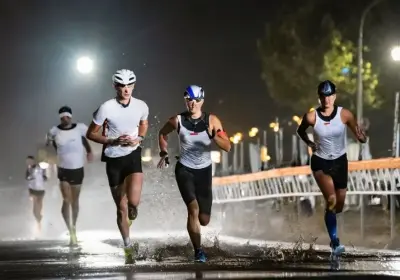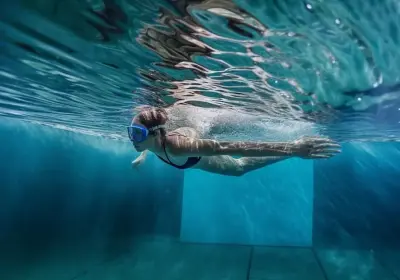How to work on your endurance in triathlon?

- 1. Understanding the Importance of Endurance in Triathlon Training
- 2. The Fundamentals of Endurance Training
- 3. Implementing Endurance Training into Your Triathlon Preparation
- - Designing An Effective Endurance Training Program
- - Integrating Endurance Training with Swimming, Cycling, and Running Sessions
- 4. Nutrition and Its Impact on Endurance Development
- 5. Tips and Techniques to Boost Endurance
- 6. Tracking Your Endurance Progress: Setting Realistic Goals and Milestones
- 7. Overcoming Common Endurance Training Challenges
1. Understanding the Importance of Endurance in Triathlon Training
Endurance in triathlon training is not merely a desirable trait, it's a necessity. Success in this demanding sport directly correlates with an individual's level of endurance. A solid endurance base not only enhances performance but also significantly mitigates the risk of injuries. Moreover, optimum endurance offers profound physical benefits including improved cardio-respiratory function, robust immune system, and efficient metabolic rate. Equally important, it instills mental toughness, imparting the ability to stay focused under extreme conditions and to maintain consistency across all three components of a triathlon event: swimming, cycling, and running. Truly, endurance is the bedrock of an elite triathlete's prowess.
- The Role of Endurance in Triathlon Success
In the multi-disciplinary sport of triathlon, endurance isn't just a desirable attribute, it's inherently essential. The triathlon's three-pronged setup – swimming, cycling, and running – demands both physical and mental fortitude. Without a doubt, endurance plays an instrumental role in securing triathlon success. Picture yourself in the heart of the competition, battling against fatigue and the relentless ticking of the clock. Your body screams for a respite, your thoughts itch to succumb to exhaustion, but thanks to your endurance training, you're able to push through. But how does endurance contribute to victory on this front? Well, enhancing your endurance is synonymous with building your body’s capacity to withstand the prolonged physical exertion that characterizes a triathlon. More than just that, it drastically bolsters your efficiency. It conditions you to maintain an optimal performance level while minimizing energy consumption. That's endurance at work. Moreover, it allows you to stay consistently competitive without succumbing to untimely fatigue. In short, building endurance creates a durable, efficient, and resilient triathlete who thrives under extensive athletic pressure! Triathlon isn’t just about speed; it’s about how long you can maintain that speed. And on that front, endurance undeniably triumphs.
- Physical and Mental Benefits of Enhanced Endurance
The strength of endurance goes beyond the physical realm, offering substantial mental benefits as well. When you enhance your endurance, you're effectively training your body to maintain effort for longer periods, staving off fatigue and enabling you to push further in your triathlon training. This physical improvement brings increased confidence and determination, two invaluable mental traits in a demanding sport such as triathlon. But the mental benefits of enhanced endurance are not confined to the race track. The discipline, resilience, and focus required in endurance training can positively impact other aspects of your life too, be it in your career or personal life. This mind-body harmony fosters a unique sense of self-awareness, paving the way for improved stress management and overall mental wellbeing. Moreover, remaining physically active through endurance training can lift your mood, reduce anxiety, and even combat depression. Who knew that training for a triathlon could become a pathway to an improved state of mental health? By embracing endurance training, you're not only building a body fit for a triathlon but also cultivating a mindset that's prepared to take on any challenge life throws your way. So, keep pushing, keep enduring, and remember, the true power of endurance lies in its capacity to transform you, physically and mentally.
2. The Fundamentals of Endurance Training
Diving into the fundamentals of endurance training gives us a unique look at the balance between speed and stamina. This intriguing science unravels the secret to prolonged physical activities without succumbing to exhaustion. Just imagine your body as an efficient machine, able to sustain long-winded efforts. Crucial in this equation is patience; endurance can’t be built overnight. It's a gradual process, testing not just physical fortitude but mental determination as well. Successfully integrating endurance training in your triathlon preparation requires careful design and balance with your usual routine. It's like adding an extra layer of challenge, but remember, it's this very challenge that will drive you past the finish line.
- The Science Behind Endurance Training
The Science Behind Endurance Training unravels quite an intriguing tapestry. At its core, it's about conditioning the body to efficiently consume, transport, and utilize oxygen during extended periods of intense exercise. This entire process, coined as aerobic metabolism, significantly influences your stamina. But how exactly does it work? Inside the powerhouse of your cells, the mitochondria; the more you train, the more mitochondria you generate. With more mitochondria at hand, you'll utilizer oxygen more effectively, hence boost your endurance! Additionally, endurance training helps in enhancing capillary density, thereby ensuring an optimal supply of oxygen and nutrients to hard-working muscles. It’s not just about the physical though. Endurance training also steels your mind, enabling you to push beyond the usual 'comfort zones' and thrive in the realm of discomfort. But remember, endurance training doesn't equate to punishing your body with non-stop strenuous activities. The key is approaching it strategically, incorporating it into your workout regimen gradually. This ensures a progressive overload, which is monumental in stimulating physiological changes. Think of it as intriguingly wooing your body into the endurance realm, rather than abruptly pushing it into uncharted territory.
- Balancing Speed and Stamina
While training for a triathlon, crafting the perfect balance between speed and stamina can seem like a daunting task. Endurance and speed represent two intricate pieces of the triathlon puzzle; without either, your performance might falter. Endurance allows you to sustain effort over a protracted period, while speed propels you towards more efficient performance and better race timings. However, emphasizing one at the expense of the other could lead to underperformance. Finding the equilibrium is therefore crucial. Start slow, increasing your speed naturally as your endurance amplifies. Make it a point to include both high-intensity interval training (HIIT) for acceleration and long, slow runs or rides for stamina growth in your training regime. Also, remember that rest is integral in this equation. Giving your body time to heal and rejuvenate can enhance both your speed and endurance. True balance lies in incorporating all these factors in symbiosis, adjusting according to your body's responses, and tuning them towards your specific triathlon goals. Moving forward, it's possible to progressively enhance your speed without compromising your endurance. Your endurance training will not only prepare you for the rigors of the triathlon but infuse agility, resilience, and velocity into your athletic arsenal.
3. Implementing Endurance Training into Your Triathlon Preparation
Incorporating endurance training into your triathlon preparation is essential for stellar performance. Building a regime that ergonomically suits your strengths, weaknesses and schedules paves the way for successful training. Diversifying your routine with swimming, cycling, and running sessions not only enhances your stamina but also prevents monotonous training. Adaptation is key! Gradually include longer run or cycle routines in your weekly regimen, which over time, will improve your body's ability to sustain prolonged exercise bouts with less fatigue. Remember, consistency is the secret sauce of endurance training. And above all, listen to your body! It is your most reliable guideline to prevent overtraining and injuries.
- Designing An Effective Endurance Training Program
Designing an effective endurance training program is not a one-size-fits-all deal. It requires careful consideration of each triathlete’s unique fitness level, goals, and availability. This process requires a fine balance between doing too little and overtraining. The strategy is to gradually increase the intensity and duration of workouts to avoid injuries but still significantly advance performance. Remarkably, a well-crafted endurance program goes beyond the workouts on the road, in the pool, and on your bike. Of utmost importance is recovery. As triathletes, our bodies need ample time to repair and adapt to the strains of the training. Chucking in rest days and shorter, low-intensity training sessions is, therefore, crucial. In the same vein, don't forget the value of cross-training. Complementary exercises, like weight lifting, can greatly enhance your stamina by building muscle strength and mass, improving balance, and preventing injuries. Strikingly, a successful endurance program doesn't ignore the mental component. Mental toughness fortifies us in those grueling moments of races and training when our bodies are screaming at us to give up. Therefore, integrate strategies for developing mental resilience, such as meditation or visualization exercises, into your routine. In conclusion, flexibility in your program is key. Life happens, our bodies have off days. Having the flexibility to adjust your training schedule as needed can make your preparation less stressful and more enjoyable. Remember, the journey is just as important as the destination.
- Integrating Endurance Training with Swimming, Cycling, and Running Sessions
Integrating endurance training with your regular triathlon disciplines - swimming, cycling, and running, isn't as complex as it seems. In fact, by smartly harmonising these different aspects, you'll be building an invincible foundation for your triathlon success. But, of course, it requires a strategic approach. For swimming, it's all about increasing your duration in water step-by-step and mastering the art of rhythmic breathing. Never underestimate the power of a measured breath; it helps conserve energy and lets you swim longer. When it comes to cycling, start with low-intensity long rides. You can gradually increase the intensity, but remember - it's a game of patience! Next, we've running, commonly dubbed as the 'ultimate endurance test'. Honestly, it's not about sprinting for a few hundred meters, it's about how long you can maintain a steady pace. A slow, consistent run would greatly bolster your endurance levels. In essence, balance is the secret ingredient. Listen to your body; if it needs rest, give it rest. Over-training can hamper your progress. Remember, endurance training is not a sprint, but a marathon. Set realistic goals, follow a disciplined routine, and watch your endurance levels gradually soar, enhancing your triathlon performance!
4. Nutrition and Its Impact on Endurance Development
Understanding the role of nutrition in endurance development can pave your way to successful triathlon training. It's no secret that what you consume directly influences your stamina and performance. Every morsel you eat can be considered fuel, charting your energy levels throughout daunting swim, cycle, and run sessions. Emphasizing balanced meals rich in proteins, carbohydrates, and essential micronutrients can elevate your stamina and facilitate quicker recovery. Keep in mind, timing is crucial! A well-timed meal - not too close, not too far from the workout - can provide the sustained energy required for intensive endurance training. The power of nutrition, thus, should never be underestimated in your triathlon preparation journey.
- Essential Nutrients for Enhanced Stamina
For any triathlete, understanding the role that nutrition, specifically, essential nutrients, play in enhancing stamina is crucial. When your body is well-nourished, it has the fuel to sustain energy levels, expediting your endurance growth. One of the key nutrients you need is complex carbohydrates. These carbs, found in foods like whole grains and legumes, act as a slow-burning fuel source to keep you going during those long and arduous training sessions. Meanwhile, proteins facilitate the repair and growth of your muscles after training, promoting better stamina for subsequent sessions. Iron and B vitamins are also essential, helping produce red blood cells and keep energy levels high. Not to mention healthy fats which provide a concentrated source of energy and help absorb vitamins. Remember, maintaining hydration, another critical element in endurance training, depends heavily on electrolytes like sodium and potassium that balance your body's fluids. Maintaining an optimal blend of these nutrients in your meal plan is a surefire way to supercharge your stamina and leave you better prepared for your next triathlon. However, the question still stands, have you got the right blend for your body?
- Meal Planning and Timing for Optimum Performance
Undeniably, meal planning and timing play a pivotal role in achieving optimum performance in your triathlon endeavors. Acknowledging this, you must strategically fuel your body with the right nutrients at the right times. Protein, for instance, aids in muscle repair, while complex carbohydrates provide sustained energy, proving invaluable during long bouts of intense training. Adequate hydration, too, cannot be overlooked. But how do you incorporate these into your everyday routine? Start by crafting a balanced diet plan that includes ample servings of lean proteins, fruits, vegetables, and healthy fats. The perfect meal plan also considers the timing. Consuming a blend of proteins and carbs before a workout – say, two or three hours prior – can stave off hunger and maintain your energy levels. Likewise, a protein-rich meal post-training can expedite muscle recovery. However, be mindful of portion sizes. Overeating can hinder your performance instead of enhancing it. Remember, your body can only utilize a certain amount of nutrients at once. The key is consistency – eating healthy, balanced meals regularly rather than resorting to extreme diets or skipping meals. Remember that every athlete is unique, and what works for one might not work for another. It's therefore essential to experiment with different meal plans and timings to decipher what works best for you.
5. Tips and Techniques to Boost Endurance
Enhancing your endurance for an upcoming triathlon demands more than just relentless training. It requires focused techniques and smart strategies designed to push your stamina to its ultimate potential. An excellent way to boost endurance is by mastering controlled breathing techniques, ensuring your muscles receive the oxygen they need for prolonged periods of energy output. In addition to training for swimming, cycling, and running, incorporating cross-training exercises into your regimen can significantly improve your overall stamina. By introducing diverse workout routines, you’re not only breaking the monotony but also challenging your body, pushing it to adapt and learn, thereby naturally boosting your endurance. Remember, building endurance is a journey, not a race!
- Breathing Techniques for Long-lasting Energy
Breathing techniques play a pivotal role in facilitating long-lasting energy for triathletes, significantly tipping the scales of endurance. Understanding how and when to breathe can be a game-changer in your triathlon journey. It isn't merely about inhaling and exhaling; it's more of a strategic process involving efficiency, rhythm, and depth of each breath. Practicing deep breathing, sometimes referred to as diaphragmatic breathing, can drastically improve your stamina. This technique involves inhaling deeply into the lungs, facilitating optimal oxygen exchange, which is fundamental for energy production. Breathing exercises such as "Box Breathing" and "4-7-8 breathing" can be integrated into your training to improve your lung capacity, ultimately boosting your endurance. Ever considered the power of rhythmic breathing? This coordination of breath with movements, particular in cycling and running, helps reduce fatigue, improves focus, and maintains your energy levels over extended periods. Also, exploring the concept of nasal breathing can be beneficial. A less known fact is that nasal breathing warms, filters, and humidifies the air, offering an enhanced oxygen uptake necessary for prolonged energy supply. Mastering these breathing techniques can transform your endurance levels and revolutionize your triathlon performance. Isn't it fascinating how such a seemingly simple habit as breathing can wield so much power over our overall endurance? And remember, consistent practice is the key to breathing your way to improved stamina.
- Cross-Training and Its Role in Building Endurance
Cross-training plays a pivotal role in developing your endurance for a triathlon. By incorporating different types of exercises outside your main sport, you expand your overall athletic skills, reducing the risk of injuries and preventing overuse of certain muscles. Cross-training essentially challenges your body in unique ways, proving instrumental in eliminating fatigue, reducing the chance of burnout, and enhancing the enjoyment factor during training. It's not only about the physical benefits; it also strengthens your mental toughness, crucial for enduring the long, strenuous hours of a triathlon. For instance, if you're a runner, try swimming or cycling once a week. This variation in workout stimulates different muscle sets, simultaneously boosting your stamina and flexibility. The diversity afforded by cross-training breaks the monotony, making your training regime not just an endurance-building program but also an enlivening adventure. This versatility not only makes you an all-rounded athlete but also keeps your enthusiasm and motivation levels intact throughout the rigorous triathlon training. Remember, like any form of exercise, the key to reaping the maximum benefits lies in striking the right balance. So, while indulging in cross-training, ensure it complements your main workout, contributing effectively towards building your endurance.
6. Tracking Your Endurance Progress: Setting Realistic Goals and Milestones
Aiming for triathlon triumph requires not just an intense training regimen, but also a practical strategy to track your endurance progress. Determining your goals and milestones, both long-term and short-term, is a crucial component in sculpting your endurance endurance for triathlon training. Having tangible, realistic aims gives you a clear sense of direction, ensuring that every bead of sweat contributes to your ultimate goal. Equipped with wearable gadgets, you can record your stamina levels, heart rate, and even your mental fatigue during each training session. The data this tech provides will help you adjust your training techniques, aligning them perfectly with your evolving endurance levels and allowing your daily progress to become your biggest motivator. It's about the growth you witness within yourself — that is the true victory.
- Setting Endurance Goals for Your Triathlon
Setting endurance goals for your triathlon is like mapping the route for an exciting journey - one that will test and showcase your strength, stamina, and determination. From absolute beginners to seasoned triathletes, setting specific, measurable, achievable, realistic, and timely (SMART) endurance goals forms the foundation of a successful triathlon experience. Why are endurance goals essential? Well, they help you remain focused and driven during your rigorous training schedule. Imagine setting out on a road trip without a map or, at the very least, a final destination in mind. You'd probably drive aimlessly, possibly going in circles, and we both know that's not the most efficient way to get anywhere. Endurance training of a triathlon demands a structured roadmap - and that's where SMART goals can guide you! Every athlete is unique – in their strength, stamina, speed, and motivation level. Therefore, a 'one-size-fits-all' goal won't work. Your endurance goal needs to align with your personal athletic capacity and ambition. How long can you swim, run, or cycle without succumbing to exhaustion? What's the furthest you've gone - could you perhaps push a little more? Remember, the aim here is not to compare and compete with others but to challenge and conquer your personal best. Setting personalized endurance goals allows you to measure your progress accurately, motivating you to persist, train harder, and inch closer to your triathlon dreams.
- Using Technology to Monitor Endurance Growth
In the world of endurance training for triathlons, technology plays an essential role that can't be underestimated. **Using technology to monitor endurance growth** isn't only a trend but a powerful tool that shapes the preparation of today's athletes. From wearable fitness trackers to sophisticated training apps, triathletes now equip themselves for results beyond the ordinary. These modern marvels allow you to track your heart rate, measure distances, and scrutinize your performance down to the most granular details. They also provide irreplaceable feedback about your progress, revealing whether your training techniques are favoring your endurance objectives or if they need recalibration. While there's nothing wrong with traditional training methods, the advantage of using technology is the ability to dissect your performance through **data analysis**. For instance, maintaining a digital training log helps you spot patterns, strengths, and areas for improvement. It can also help you gauge your body’s response to different training intensities. Over time, this valuable information can guide you in personalizing your training plan for maximum endurance growth. Ultimately, the objective is to raise the bar higher than ever before. As with anything, **the effective utilization of technology**, when coupled with human determination and resilience, can lead to results that are a testament to human potential. Is that not the ultimate pursuit of every endurance athlete?
7. Overcoming Common Endurance Training Challenges
A pivotal part of every triathlete's journey hinges on overcoming the inevitable challenges associated with endurance training. Fatigue, burnout, and injuries are common roadblocks that may hinder your performance, but remain undeterred! Managing these hurdles is essential for your enduring stamina. Try maintaining a balance in your workout regimen to prevent over-exertion and remember, it's okay to take it easy to avoid burnout. In case of injuries, don't push through the pain, let your body heal! Adopt a structured recovery routine that includes adequate rest, nutrition, and perhaps, physiotherapy. While these challenges may impede your journey momentarily, they indeed fortify your resolve, paving the path to your triathlon success.
- Coping with Fatigue and Burnout
Coping with fatigue and burnout is a critical part of any athlete's journey, especially when training for a rigorous event like a triathlon. It’s not uncommon to encounter burnout given the intense physical and mental demands of the sport. It’s important to acknowledge that feeling exhausted or lacking motivation doesn’t equate to failure. It's merely your body’s way of telling you it needs a break. Implementing periods of rest and recovery into your training schedule is essential. This not only recharges the body but also renews the mind. Interval training is a wise strategy to apply. This balances sessions of high-intensity workouts with periods of lower intensity exercises, preventing excessive strain on the body. Also vitally important is paying attention to your body's signals. If you notice persistent tiredness, moodiness, or a drop in your performance, these are likely signs of overtraining and burnout. Taking a step back, or even a few days off, may seem counterproductive. However, it can massively pay off in significantly improving your overall endurance in the long run. Never underestimate the power of a good night's sleep and balanced nutrition. Total wellness should be a standard part of your endurance training journey for your triathlon goals.
- Dealing with Injuries and Setbacks.
During the grueling journey of striving for triathlon success, dealing with injuries and setbacks is an inevitable part of the process. When confronted with physical hurdles, it is paramount not to let these momentary obstacles demoralize you or derail your training plan. Recovery, hence, should be your primary focus. Including low impact exercises, such as swimming or cycling, can conserve your strength and yet allow your body the needed recovery time. It is equally vital to have a positive mindset. Pain, exhaustion, and injuries are temporary, but your dedication to building your endurance is unyielding. Remember, setbacks make comebacks stronger. So, see these as opportunities to bounce back with a sturdier resolve. Incorporate strength training into your regime not just for rehabilitation but also for preventing future injuries. Don't just heal, strengthen. Above all, listen to your body. Discern between pushing your limits and pushing over your limits. Understand the difference between discomfort of growth and pain of injury. Nurture your body, nourish your resilience. The pathway to endurance is as much about overcoming physical challenges as it is about holding steadfast even when faced with setbacks. Stay resilient, and remember, the true mark of endurance is persisting, despite the odds.</
Training for endurance in triathlons is a critical aspect that combines understanding the importance, implementing targeted training, balanced nutrition, and effective tracking of progress. Incorporating tips and techniques, while overcoming challenges, is vital in achieving your triathlon goals. Always remember, consistency in endurance training is key to empowering your physical and mental strengths, adapting your body to exert optimum performance in triathlons.
```html
How does endurance affect my triathlon performance?
Endurance training contributes to triathlon performance by boosting stamina and energy levels, improving cardiovascular health, enhancing muscle strength, and increasing mental resilience.
What are the fundamentals of endurance training for triathlons?
Endurance training for triathlons is anchored on sound science and involves striking a balance between speed and stamina. It includes methods such as high-intensity interval training (HIIT), steady-state cardio exercises, and sports-specific training sessions to mimic triathlon conditions.
How do I incorporate endurance training into my triathlon preparation?
Design an effective endurance training program that complements your existing triathlon routine. A comprehensive plan might include swimming, cycling, and running sessions interwoven with endurance exercises.
How does nutrition impact my endurance during triathlons?
Nutrition greatly affects endurance. Consuming essential nutrients like complex carbohydrates, proteins, and healthy fats can increase your stamina. Also, meal planning and correct timing can optimize your performance during triathlons.
How can I overcome common endurance training challenges?
Common challenges during endurance training include fatigue, burnout, injuries, and other setbacks. Manage these effectively with appropriate rest, recovery techniques, and a balanced training program. Consulting with health and fitness professionals can also guide you in facing these issues.
```


















































Leave a comment